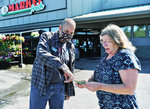





Collectors from around the world are vying to snap up Tenino’s wooden scrip — in some cases bidding up to 12 times the cedar cards’ $25 value — and the phenomenon seems to be tickling pink Tenino Mayor Wayne Fournier.
“The fact that the Tenino currency is the highest valued currency in circulation dollar for dollar in the world right now is an amazing statement,” Fournier said last week. “The program is an inspiration worldwide, and that’s pretty mind boggling.”
Moreover, he added, the program’s phenomenal publicity has prompted half a dozen donations totaling about $6,000, and other cities around the country have been contacting city hall to find out more about the grant program and how they might establish one of their own.
The Tenino City Council approved an ordinance on May 4 initially authorizing the printing of $10,000 worth of wooden scrip with potentially more funds allocated in the future. And though the city’s initial investment was relatively small, the combined potential outcome if other cities follow suit could be monumental, Fournier said.
“Perhaps $10,000 is not a lot of money to invest in a program, but if just 5,000 other cities in the United States set aside $10,000 for their own programs it would inject $50 million into the economy.”
Or help sustain an unemployed public school employee with a $300 per month infusion of desperately needed cash.
For longtime Tenino resident Lauretta Mahlenbrei, the simple index-sized wooden cards featuring George Washington’s face and a $25 symbol are anything but pretentious collector’s items. They’re utilitarian, plain and simple, and they have saved her bacon — and freed her from cleaning people’s toilets just to buy food for her ailing dog.
Mahlenbrei, a Tenino School District bus driver, has been out of work since March 13 when Gov. Jay Inslee ordered all state schools to close to help combat the coronavirus.
For the following 2 ½ months the 63-year-old tried to make ends meet on the $250 per week the school district continued to pay her for her regular bus route, but her typical extra trips, which could double her salary — such as driving students on field trips and sports teams to games — evaporated when the schools closed.
“That’s all I had to live on for those months was the regular bus driver route money, and it wasn’t enough to pay my bills,” Mahlenbrei said last week. “So, thankfully, some people I knew from church paid me to do odd jobs and cleaning around their houses to help me get by.”
But on May 28 — after jumping through a few hoops at city hall, she said — Tenino’s COVID-19 Recovery Grant Program rescued her. On that day she received 12 wooden cards bearing Washington’s face, each marked $25. The $300 total was redeemable at a variety of businesses around town that had agreed to participate in the grant program.
And then on June 10 — as her money was again set to run out — the city approved her second COVID-19 Recovery grant application, and she subsequently received another $300 scrip installment.
“I think it’s really awesome that Tenino did this, because it helps the businesses in town, and it helped me, because I needed the money to survive,” Mahlenbrei said. “It made my life a lot better, and it was a big relief when I got it.”
Mahlenbrei was, in fact, one of the first Tenino residents to qualify for the wooden scrip and is to date the only one to receive more than one grant. So far, she has used scrip to purchase merchandise or services at about five out of the 14 Tenino businesses participating in the program.
And on a sunny late-June day in front of Tenino Market Fresh, Whidbey Island resident Franc Sawatzki approached Mahlenbrei with an offer he hoped she couldn’t refuse. The 55-year-old wanted to buy three of her scrip for souvenirs — but before he could even name a price Mahlenbrei was gently refusing.
“I’d heard about the wooden dollars and wanted to buy a few to help out the small town,” he said. “I wanted one for myself and two for relatives.”
Sawatzki, clad in a National Public Radio T-shirt and surgical mask — seemed genuinely interested in the history and design of the scrip, and after chatting with Mahlenbrei for a few minutes went on his way in search of someone else willing to sell the elusive wooden currency.
Though Tenino’s wooden money is drawing widespread attention as a unique response to a debilitating crisis, it’s not the first time the city has printed “currency” in such a fashion.
Patterned after a similar wooden scrip program initiated in 1931 during the height of the Great Depression, the city initiated its modern version — deemed the COVID-19 Recovery Grant Program — to promote a goal similar to the one 90 years ago: Keep the economy afloat and the city’s neediest residents fed and clothed.
The scrip program works like this: To be eligible to receive up to $300 maximum scrip per month, verified residents of Tenino — who can prove they have a Tenino utility account — must meet federal poverty income guidelines and prove that their livelihoods — either through direct illness or loss of income — have been harmed by COVID-19.
The idea for the scrip program materialized from discussions Tenino leaders undertook as the pandemic began to devastate Washington. The scrip, printed in $25 amounts, is backed by the city’s general fund and may be used to purchase just about anything other than products containing alcohol, tobacco or cannabis. It can also be used for some licensed services such as child care or a doctor’s appointment and as credit on a utility account.
While the scrip has no intrinsic cash value, businesses treat it the same as currency, but instead of depositing the scrip into the bank, it’s redeemed by the city, which then issues a check to each business participating in the program.
Maria Williams’ business is among them, and though she’s enthusiastic about the intent of the grant program, recent circumstances have dampened her mood.
Through Wednesday, June 24, the owner of Tenino Coffee Bistro had fielded at least seven telephone calls from people as far away as New York wanting to purchase Tenino wooden scrip — for as much as $300 per $25 scrip card.
Williams, who says she was “one of the very few people who tried to open a business during COVID-19,” has been operating since April 1. So far, she has had no customers offer wooden scrip to buy drink, food or other merchandise in her store — which includes white T-shirts emblazoned with images of the scrip.
But she’s received plenty of calls offering to buy the cedar cards.
“As a community member, that frustrates and angers me,” she said. “What’s the purpose of the scrip if it’s not coming back into the community?”
“It seems funny to make a comment like that,” Fournier responded, noting that some scrip will end up circulated and some won’t. “Our goal is to benefit the citizens and help those negatively affected by the pandemic.
“You can’t say that the recipient receiving the Tenino dollar isn’t being helped if it’s valued higher than the face value,” Fournier added. “It’s a weird happenstance, but it’s not a negative thing that the Tenino dollar is valued so much higher.”
As of June 25, the city had received six applications for scrip assistance, five of them approved. Four recipients were granted the full $300 and another $250 — one of the first grants provided on May 28 to Mahlenbrei — for a total distribution so far of $1,450. Of that sum, three recipients chose to apply $375 to their utilities accounts.
According to John Millard, Tenino clerk-treasurer, no participating Tenino merchants have yet to redeem scrip. Millard knows of at least one Tenino business owner who chose to keep the scip as a memento and not redeem it.
But there are other reasons the scrip has not been redeemed: Some businesses haven’t received any.
Tenino Market Fresh is an exception.
Store Manager Chris Hamilton, 43, said he has had five or six customers since late May use the scrip to purchase merchandise.
“The scrip comes in periodically,” he said. “I don’t have a slot in my till for it, because we’re not getting boatloads of it in. I think, though, as the program continues to grow, we’ll see more of it.”
Like Williams, Hamilton’s received frequent calls from collectors wanting to buy scrip.
“I had people calling about the scrip before it was even printed,” he said. “It’s a novelty, nostalgia thing. I get calls just about every day.”
Down Tenino’s main drag at Hedden’s Pharmacy, co-owner Brian Hedden, 61, is fielding calls every day from collectors wanting to purchase scrip. He’s had about 30 calls in the past month, he said, but as yet nobody’s used scrip to purchase anything in the pharmacy.
“Unfortunately, it’s not a good situation in that respect where people can just sell the scrip,” he added. “If people can obtain a $25 scrip and turn it into a profit, then it just defeats the purpose. It’s costing the city money, because it’s not getting back into circulation.”
Millard has a different point of view on the situation.
“If an individual is able to to sell a scrip for $500, let’s say, it has helped that grant recipient,” he said. “Now the recipient has $500 to spend in the community instead of $25.”
If the money stays in Tenino.
“Of course, we just don’t know if that will be the case, because that person might take the money to Olympia and buy a set of tires with it,” Millard added.
The program, vetted in early May by the city attorney and enthusiastically supported by the city council, was awaiting at that time a review by the state Auditor’s Office to ensure its legality.
That never happened.
The auditor declined, noting to Millard that “they were not in the business of ‘approving’ such programs, per se.” Instead, the state office said it would review the program and offer suggestions relating to internal controls that would be germaine when the 2021 audit rolled around.
In response, the city altered its original grant ordinance to reflect the auditor’s suggestions and in so doing added internal controls that would ensure the program’s overall integrity and legitimacy.
But besides its practical function as a municipal ordinance, the COVID-19 Recovery Grant Program’s wooden scrip has also by its nature been an art form unto itself.
According to Fournier, each coupon of scrip — which is as thick as a typical sheet of construction paper — was cut and stamped individually. And the fellow who made all of this happen Fournier calls the area’s “Renaissance man,” Loren Ackerman.
Ackerman, president of the South Thurston Historical Society, cut and stamped the notes on a late 1870s-era printing press that was used to print the original Great Depression scrip.
And despite burning through most of her wooden scrip by the end of June, Mahlenbrei’s recent financial difficulty seems to be easing into the past, too.
When the bus driver’s Tenino School District pay ended on June 12, she was eligible to apply for unemployment insurance and sure enough received her first weekly $735 check on June 25. And ironically, her $1,200 federal CARES Act stimulus check arrived the exact same day.
Now that would tickle anyone pink, wouldn’t it?
•••
Interested in applying for the COVID-19 Recovery Grant Program? Just follow this link: https://cityoftenino.us/sites/default/files/fileattachments/city_hall/page/2101/5-ordinance910-exh1-tabc-200828.pdf